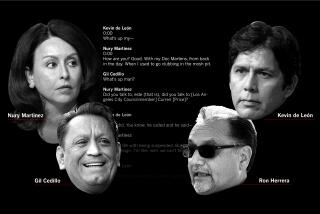Geography: Mapping the future with Esri
Jack Dangermond started his working life at his parents’ plant nursery in Redlands. Now, Forbes says, he’s a billionaire.
Dangermond is founder and president of Esri, one of the world’s leading geographic information systems companies. In 2010, he won the Alexander Graham Bell Medal from the National Geographic Society and the Patron’s Medal from England’s Royal Geographical Society. Recently we asked him to talk about Geographic Information Systems, or GIS, and his vision for them.
What is GIS, and where did it come from?
In the early to mid-1960s, people started fooling around with something I call computational geography. Roger Tomlinson in Canada first coined the name GIS, but others like my professor Howard Fisher at Harvard were making computer maps.
There was a shift from qualitative descriptions of places to the notion that we could put geographic data into a computer and do quantitative analytics, engaging theories of database management that were emerging in accounting.
Once you digitize data you can actually analyze patterns and relationships in geographic space — relationships between certain health patterns and air or water pollution, between plants and climate, soils, landscape.
The applications moved quickly beyond the laboratory; businesses started getting engaged, then cities realized they could have a centralized GIS database, updated about road changes, sewer lines, building permits, land-use plans.
States and national agencies started to embrace these same ideas for making better decisions, communicating more effectively and encouraging collaboration between departments.
The key word is integration. GIS organizes geography into layers. Engineers maintain their layer, planners theirs. There are layers about sociology, geology, climatology, hydrology, etc. GIS is the only technology that actually integrates many different subjects using geography as its common framework.
Where does satellite imagery fit in?
From my perspective, satellite imagery is one of these layers, along with real-time layers like GPS tracks and geo-referenced social media. I can put tweets on a map to show who is saying what where, which could be used for marketing or social research.
At the time of the tsunami in Japan we made a map of tweets and Facebook posts, so you could open a map and see what people were saying and look at videos in near real-time.
How do you make your GIS tools available?
GIS started on mainframe computers; we could get one map every five to 10 hours, and if we made a mistake it could take longer. In the early ‘90s when people started buying PCs, we migrated to desktop software. Then with the Web we developed a server-based technology.
The most recent change is a shift to the cloud; Esri has put GIS software in the cloud and built a new app called ArcGIS Online, a subscription-based service that makes more than 100 million maps a day.
There are base maps, imagery and tools in this service. It’s very exciting to people because they can search and discover data already in the cloud and make maps of all sorts.
It’s like what Apple did with the iPhone and the music industry. Geography is the music of ArcGIS Online, and you can access all this fantastic map music from an iPhone or iPad.
ArcGIS has traditionally been a professional’s technology, but now we are seeing organizations that have never touched GIS using it. Lots of cities are registering for ArcGis Online and putting their data in it. It’s a brand new platform, so scaling up to 100 million maps a day in seven months is quite an achievement.
What does GIS have to do with “big data”?
“Big data” is a new category of very, very large data sets, often real-time, like reading the locations of every cellphone in America every second, or the weather for the whole world at once, or sales going on in an organization as big as Wal-Mart.
Imagine this information coming into a funnel that pours it into a pipeline able to manipulate the data stream and ask a question of it.
So with GIS we are moving into real-time big data, and we can do things like geo-fencing. Perhaps you have a map in front of you and you draw a fence around a neighborhood where you don’t want your kids to go. This geo-fence is set up between you and your telephone company, so if your kids have cellphones and go into this area, you are sent an email.
Or let’s take a military example. Let’s assume you have the cellphone of some bad guys who are getting close to a U.S. Embassy. Geo-fencing could give notification before they get there and a bomb goes off.
And there are consumer applications. Suppose you drive into a national park and want to get an email about where bears have been sighted or a special lecture is being given. That’s a pretty interesting example for a traveler.
Google is walking across the market for things like this. Theirs is a consumer-oriented, well-orchestrated, beautiful base map, with simple services for people to view and find their way around. We are more focused on building tools for government agencies and businesses, and the sharing of authoritative information sets.
Have you heard of Al Gore’s Digital Earth concept?
I was in the audience when he gave the speech [in 1998]. Over the next year my plan is to take Esri’s deeper tools and consumerize them, not for revenue but to move geography along and get people more conscious of their world.
My philosophy is that understanding should precede action. You and I learned the dangers of smoking, and look what it did to society. My hope is that as people learn what they are doing to their environment, they are going to wake up with an I-don’t-want-to-smoke-anymore reaction.
More to Read
Sign up for The Wild
We’ll help you find the best places to hike, bike and run, as well as the perfect silent spots for meditation and yoga.
You may occasionally receive promotional content from the Los Angeles Times.






